

IV.10.2 Palladium-Catalyzed Benzannulation
Reactions of Conjugated Enynes and Diynes
SHINICHI SAITO and YOSHINORI YAMAMOTO
A. INTRODUCTION
As shown in the previous section and in other sections, palladium complexes are good catalysts for the activation of conjugated dienes, allenes as well as alkynes, and the Pd-catalyzed dimerizations and/or oligomerizations of such compounds are observed. Since no by-products (inorganic salt, etc.) are produced in these reactions, and new carbon–carbon bonds are formed from relatively inert compounds, which are not activated by leaving groups and so on, it is highly desirable to develop such types of reactions. Compared to the frequent use of conjugated dienes for Pd-catalyzed reactions, conjugated enynes were not employed as substrates for Pd-catalyzed oligomerization. In an initial study of a Ni-catalyzed reaction, conjugated enynes cyclotrimerized to give trisubstituted benzenes and therefore conjugated enynes were considered as “substituted alkynes.”[1] Though conjugated enynes have been reported to undergo Lewis-acid-catalyzed and thermal [4 2] cycloaddition reactions,[2] the oligomerization of conjugated enynes in the presence of Pd catalysts has never been mentioned.
In 1996, a new type of Pd-catalyzed reaction of unsaturated hydrocarbons was discovered.[3] Conjugated enynes cyclodimerize in the presence of Pd(0) catalysts to give disubstituted benzenes in high yields (benzannulation). Later, it was found that conjugated enynes undergo cross-benzannulation with conjugated diynes.[4] In most cases, these reactions give single products and no by-products are produced (Scheme 1). These reactions were applied to the preparation of many oligosubstituted aromatic compounds, which are not easily accessible by other synthetic methodologies.
B. CYCLODIMERIZATION OF CONJUGATED ENYNES (HOMOBENZANNULATION)
Conjugated enynes cyclodimerize in the presence of Pd(PPh3)4 to give substituted benzenes. The mode of the cyclodimerization is strictly controlled as shown in Scheme 2, with 1,4-disubstituted benzenes obtained as the sole products. Though it has been
Handbook of Organopalladium Chemistry for Organic Synthesis, Edited by Ei-ichi Negishi ISBN 0-471-31506-0 © 2002 John Wiley & Sons, Inc.
1635
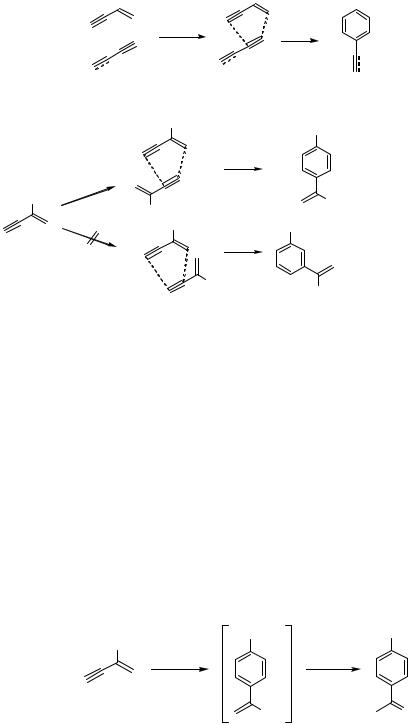
1636 IV Pd-CATALYZED REACTIONS INVOLVING CARBOPALLADATION
3 |
2 |
1 |
4 |
|
+ |
Pd(0) |
|
|
|
Scheme 1 |
|
R |
R |
|
|
|
|
Pd(0) |
|
R |
R |
R |
|
|
|
2 |
R |
R |
R |
not formed |
R |
|
||
|
|
Scheme 2
shown that some Pd compounds are efficient catalysts for the cyclotrimerization of alkynes,[5] the cyclotrimerization of conjugated enynes was not observed. It is also noteworthy that the reaction proceeded only in the presence of some Pd catalysts, and the reaction was not promoted by other transition metal catalysts such as CpCo(CO)2[6] or RhCl(PPh3)2,[7] which are effective catalysts for the cyclotrimerization of alkynes. Substituents could be introduced at the 2- or 4-position of the enynes, and 2-substituted enynes showed the highest reactivity. The reactions of 2-substituted enynes are summarized in Table 1, and the reactions of 4-substituted enynes are summarized in Tables 2 and 3. As shown, many functional groups including carbonyl groups, hydroxyl groups, and amino groups are tolerated for this reaction. A substituted phenol was obtained when an oxygen atom was introduced at the 2-position (Scheme 3).[8] At present, the scope of this reaction is limited to 2- or 4-substituted enynes, and the homobenzannulation of other substituted enynes has not been reported: the reactivity of the conjugated enynes becomes lower when the number of substituents becomes larger or a substituent is attached at the 1-position. The attempts to carry out the cross-benzannulation between different conjugated enynes turned out to be unsuccessful, giving mixtures of isomers in most cases (Table 4).[9]
OMe |
OMe |
OMe |
|
Pd(0) |
silica gel |
OMe |
O |
52%
Scheme 3
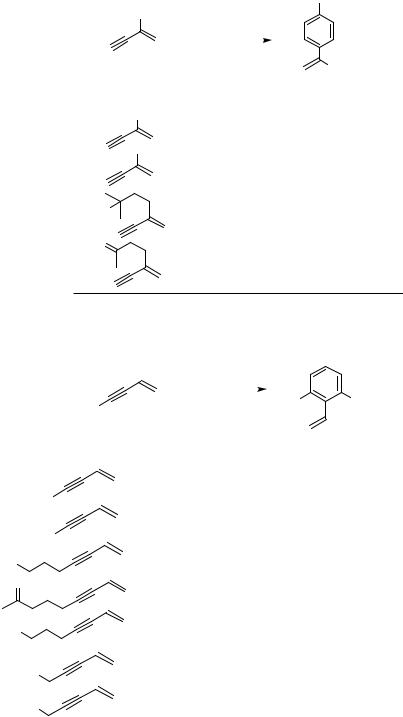
IV.10.2 Pd-CATALYZED BENZANNULATION REACTIONS |
1637 |
TABLE 1. Pd-Catalyzed Homobenzannulation of 2-Substituted
Conjugated Enynes
|
|
R |
R |
|
|
|
2 mol % Pd(PPh3)4 |
|
|
|
|
1 |
toluene, 65 °C, 1 h |
|
|
R 2 |
|
|
|
|
Enyne |
|
Yield (%) |
|
|
|
n-C6H13 |
77 |
|
|
||
CH3 |
|
70a |
|
81 |
|
HO |
|
O |
82 |
|
aThe reaction was carried out with 2 mmol of the enyne in the presence of 1 mol % of Pd(PPh3)4.
TABLE 2. Pd-Catalyzed Homobenzannulation of 4-Substituted Conjugated Enynes (Alkyl Group)
|
|
|
cat. Pd(0) |
|
|
|
|
|
|
|
|
|
|
|
|
|
R |
|
THF, 100 °C |
R |
R |
|
|
|
|
|
|
|
|
|
|
|
3 (R = alkyl group) |
|
|
|
|
4 |
|
|
|
|
|
|
|
|
|
Enyne |
|
|
Catalyst |
|
Time (h) |
Yield (%) |
|
|
|
|
|
|
|
||
|
|
1 mol % Pd(PPh3)4 |
|
24 |
86 |
||
n-C6H13 |
|
10 mol % COD |
|
|
|
||
|
1 mol % Pd(PPh3)4 |
|
10 |
92 |
|||
|
|
|
|||||
n-C10H21 |
|
10 mol % COD |
|
|
|
||
|
1 mol % Pd(PPh3)4 |
|
22 |
30 |
|||
Cl |
|
|
|||||
|
10 mol % COD |
|
|
|
|||
O |
|
1 mol % Pd(PPh3)4 |
|
72 |
51 |
||
HO |
|
1 mol % Pd(PPh3)4 |
|
66 |
81 |
||
|
10 mol % P(o-Tol)3 |
|
|
|
|||
|
|
1 mol % Pd(PPh3)4 |
|
24 |
100 |
||
MeO |
|
10 mol % P(o-Tol)3 |
|
|
|
||
|
|
1 mol % Pd(PPh3)4 |
|
24 |
100 |
||
Et2N |
|
10 mol % P(o-Tol)3 |
|
|
|
||
|
|
|
|
|
|
|
|

1638 IV Pd-CATALYZED REACTIONS INVOLVING CARBOPALLADATION
TABLE 3. Pd-Catalyzed Homobenzannulation of 4-Substituted Conjugated Enynes (Aryl Group)
|
|
|
cat. Pd(0) |
|
|
|
|
|
|||
|
|
|
|
|
|
|
|
|
|||
R |
|
|
THF, 100 °C |
|
R |
R |
|
||||
|
|
|
|
|
|
|
|
|
|
|
|
3 (R = alkyl group) |
|
|
|
|
|
4 |
|
||||
|
|
|
|
|
|
|
|
||||
Enyne |
|
|
Catalyst |
|
|
Time (h) |
Yield (%) |
||||
|
|
|
|
|
|
||||||
|
|
5 mol % Pd(PPh3)4 |
48 |
|
71 |
||||||
|
|
1 mol % Pd(PPh3)4 |
84 |
|
71 |
||||||
|
|
10 mol % COD |
|
|
|
||||||
|
|
1 mol % Pd(PPh3)4 |
96 |
|
40 |
||||||
|
|
10 mol % P(o-Tol)3 |
|
|
|
||||||
MeO |
|
|
|
|
|
|
|
|
|
|
|
|
|
1 mol % Pd(PPh3)4 |
48 |
|
80 |
||||||
|
|
10 mol % P(o-Tol)3 |
|
|
|
||||||
F |
|
|
|
|
|
|
|
|
|
|
|
|
|
1 mol % Pd(PPh3)4 |
24 |
|
69 |
||||||
O |
|
10 mol % P(o-Tol)3 |
|
|
|
||||||
|
|
|
|
|
|
|
|
|
|
|
|
|
|
1 mol % Pd(PPh3)4 |
48 |
|
81 |
||||||
S |
|
10 mol % P(o-Tol)3 |
|
|
|
||||||
|
|
|
|
|
|
|
|
|
|
|
|
|
|||||||||||
TABLE 4. Pd-Catalyzed Cross-Benzannulation Between 4-Substituted Conjugated Enynes |
|||||||||||
|
|
|
|
|
|
|
1 mol % Pd(PPh3)4− |
|
|||
|
+ |
|
|
|
|
|
10 mol % P(o-Tol)3 |
|
|||
n-C6H13 |
|
R |
|
|
|
|
THF, 100 °C |
|
|
||
|
|
|
|
|
|
|
|
|
|||
n-C6H13 |
n-C6H13 |
+ n-C |
H |
13 |
|
|
R |
+ R |
R |
||
|
|
6 |
|
|
|
|
|
|
|
||
5 |
|
|
|
|
|
|
6 |
|
|
|
7 |
|
|
|
|
|
|
|
|
|
|
||
R |
Yield of 5 (%) |
|
|
|
Yield of 6 (%) |
|
|
Yield of 7 (%) |
|||
|
|
|
|
|
|
|
|
|
|
|
|
Ph |
13 |
|
|
|
|
|
19 |
|
|
23 |
|
MeOCH2 |
5 |
|
|
|
|
|
15 |
|
|
80 |
|
t-Bu |
36 |
|
|
|
|
|
0 |
|
|
0 |
|
Me3Si |
0 |
|
|
|
|
|
0 |
|
|
0 |
|
-Naphthyl |
25 |
|
|
|
|
|
23 |
|
|
0 |
|
|
|
|
|
|
|
|
|
|
|
|
|
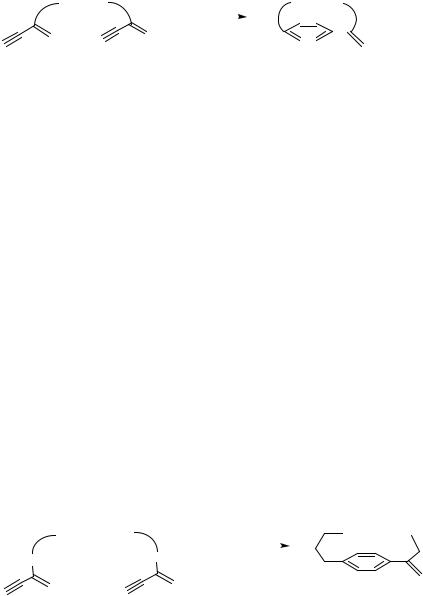
|
|
IV.10.2 |
Pd-CATALYZED BENZANNULATION REACTIONS |
1639 |
||||||||
TABLE 5. Synthesis of [n]Paracyclophanes 9 (n m 1) from Bis-enynes 8 a |
|
|
||||||||||
|
|
(CH2)m |
|
cat. Pd(PPh3)4 |
(CH2)m |
|
|
|||||
|
|
|
|
|
|
|
|
|
|
9 (m = 7−14) |
||
|
|
|
|
toluene, 100 °C, |
|
|
|
|
||||
|
|
|
|
|
||||||||
|
8 (m = 7−14) |
|
high dilution |
|
|
|
|
|
|
|
||
|
|
|
|
|
|
|
|
|||||
|
|
|
|
|
|
|
|
|
|
|
|
|
|
|
Reaction |
|
Conditions |
|
|
|
|
|
|
|
|
|
|
|
|
|
|
|
|
|
|
|
|
|
|
|
|
|
Concentration of 8 |
|
|
|
|
|
|
|
|
Enyne |
|
Pd(PPh3)4 (mol %) |
|
(mM) |
|
Time (min) |
Yield of 9 (%) |
|||||
|
|
|
|
|
|
|
|
|
|
|
|
|
8a (m 7) |
40 |
2.5 |
|
20 |
|
|
1.7 |
|||||
8b (m 8) |
40 |
2.5 |
|
30 |
|
|
18 |
|||||
8c (m 9) |
40 |
2.5 |
|
15 |
|
|
36 |
|||||
8d (m 10) |
40 |
2.5 |
|
15 |
|
|
47 |
|||||
|
20 |
8.3 |
|
90 |
|
|
28 a, b |
|||||
|
20 |
25 |
|
60 |
|
|
7 a, c |
|||||
8e (m 11) |
40 |
2.5 |
|
15 |
|
|
61 |
|||||
|
10 |
2.5 |
|
25 |
|
|
51 |
|||||
8f (m 12) |
40 |
5 |
|
15 |
|
|
71 |
|||||
|
10 |
5 |
|
15 |
|
|
59 |
|||||
8g (m 14) |
40 |
5 |
|
10 |
|
|
71 |
|||||
|
10 |
5 |
|
15 |
|
|
67 |
|||||
|
|
|
|
|
|
|
|
|
|
|
|
|
aThe reaction was carried out at 80 °C.
bAn inseparable mixture of cyclic dimers (M 484) was obtained in 27% yield.
cA mixture of cyclic dimers was obtained in 7% yield.
This reaction was also carried out in an intramolecular fashion, yielding a series of cyclophanes (Table 5).[10] Even strained [n]paracyclophanes could be prepared by this procedure, and the thermodynamically more stable metacyclophanes were not isolated. This result indicates that the regiochemistry of this reaction is strictly controlled. In these cases the intramolecular reaction competed with the intermolecular one; therefore, the reaction should be carried out under high dilution conditions, especially when the number m of the methylene groups of the bis-enyne becomes smaller (Table 5). The prepared strained [n]paracyclophanes possess some interesting properties. [n]Oligooxacyclophanes 11 could also be prepared by this procedure (Table 6).[11] It is noteworthy that the yields
TABLE 6. Synthesis of [n]Oligooxaparacyclophanes 11 from 10 (n 3m 5)
|
|
(OCH2CH2)m |
|
Pd(PPh3)4-ligand |
(OCH2CH2)m |
|||
(CH2)3 |
CH2 |
DMSO, 100 °C |
|
|
|
|||
|
|
|
|
15−30 min |
11 (m = 2−5) |
|
||
|
10 (m = 2−5) |
|
high dilution |
|
||||
|
|
|
|
|
|
|
||
|
|
Reaction |
Conditions |
|
|
|
|
|
|
|
|
|
|
|
|
|
|
|
|
Pd(PPh3)4 |
Concentration of 10 |
Amount of |
Yield of |
|||
Enyne |
|
(mmol) |
(mM) |
|
Ligand |
Ligand (mol %) |
11 (%) |
|
|
|
|
|
|
|
|
|
|
10a (m 2) |
4 |
20 |
|
PPh3 |
50 |
34 |
||
10b (m 3) |
5 |
15 |
|
PPh3 |
40 |
100 |
||
10c (m 4) |
4 |
7 |
|
P( -Tol)3 |
12 |
95 a |
||
10d (m 5) |
10 |
5 |
|
P( -Tol)3 |
30 |
50 a |
||
a Yield determined by NMR spectroscopy.

1640 IV Pd-CATALYZED REACTIONS INVOLVING CARBOPALLADATION
of the oxacyclophanes are higher compared to those of their hydrocarbon analogs. The higher yields were explained in terms of the coordination of the oxygen atoms to the palladium catalyst.
C. CYCLOTRIMERIZATION OF CONJUGATED DIYNES
Another type of benzannulation, which might be related to the benzannulation of conjugated enynes, is the Pd-catalyzed cyclotrimerization of 1,3-diynes (Scheme 4).[12] 1,3-Diynes cyclotrimerize in the presence of a Pd catalyst to give 1,3,5-trisubstituted benzene derivatives. In this reaction, too, the regioselectivity is perfectly controlled as shown in Scheme 4, and other products were never isolated. The reaction of various diynes is summarized in Table 7. Some functional groups such as olefins and ether linkages may be present in the side chain. An example for the cross-cyclotrimerization of a diyne and an alkyne has also been reported (Scheme 5).[12]
TABLE 7. Pd-Catalyzed Cyclotrimerization of Conjugated Diynes
|
|
|
|
|
|
|
|
|
|
|
|
|
|
|
|
|
|
|
|
|
|
|
|
|
|
|
|
|
|
|
|
|
|
|
|
|
|
|
R |
|
|
|
R |
|
|
|
|
|
|
|
|
|
|
|
|
|
|
|
|
|
|
|
|
|
|
|
|
|
|
|
|
|
|
|
|
Pd(0) |
|
||||
|
|
|
|
|
|
|
|
|
|
|
|
|
|
|
|
|
|
|
|
|
|
|
|
|
|
|
|
|
|
|
|
|
|
|
|
|
||||
|
|
|
|
|
|
|
|
|
|
|
|
|
|
|
|
|
|
|
|
|
|
|
|
|
|
|
|
|
|
|
|
|
|
|
||||||
|
|
|
|
|
|
|
|
|
|
|
|
|
|
|
|
|
|
|
|
|
|
|
|
|
|
|
|
|
|
|
|
|
|
|
|
|
|
THF, reflux |
|
|
12 |
|
|
|
|
|
|
|
|
|
|
|
|
|
|
|
|
|
|
|
|
|
|
|
|
|
15 h |
|
|||||||||||||
|
|
|
|
|
|
|
|
|
|
|
|
|
|
|
|
|
|
|
|
|
|
|
|
|
|
R |
|
|||||||||||||
|
|
|
|
|
|
|
|
|
|
|
|
|
|
|
|
|
|
|
|
|
|
|
|
|
|
|
|
|
|
|
13 |
R |
||||||||
|
|
|
|
|
|
|
|
|
|
|
|
|
|
|
|
|
|
|
||||||||||||||||||||||
|
|
|
|
|
|
|
|
Diyne |
|
|
|
|
|
|
|
|
Catalyst |
Yield (%) |
||||||||||||||||||||||
|
|
|
|
|
|
|
|
|
|
|
|
|
|
|
|
|
|
|
|
|
|
|
|
|
|
|
|
|
|
|
|
|
|
|
|
|
|
|
|
|
n-C6H13 |
|
|
|
|
|
|
|
|
|
|
|
|
|
|
|
|
|
|
|
|
|
|
|
|
|
|
|
|
|
|
|
|
|
|
|
|
5 mol % Pd(dba)2 |
64 |
||
|
|
|
|
|
|
|
|
|
|
|
|
|
|
|
|
|
|
|
|
|
|
|
|
|
|
|
|
|
|
|
|
|
|
|
|
20 mol % PPh3 |
|
|||
|
|
|
|
|
|
|
|
|
|
|
|
|
|
|
|
|
|
|
|
|
|
|
|
|
|
|
|
|
|
|
||||||||||
|
|
|
|
|
|
|
|
|
|
|
|
|
|
|
|
|
|
|
|
|
|
|
|
|
|
|
|
|
|
|
|
|
|
|
|
|
||||
|
|
|
|
|
|
|
|
|
|
|
|
|
|
|
|
|
|
|
|
|
|
|
|
|
|
|
|
|
|
|
|
|
|
|
|
|
|
|
|
|
n-C10H21 |
|
|
|
|
|
|
|
|
|
|
|
|
|
|
|
|
|
|
|
|
|
|
|
|
|
|
|
|
|
|
|
|
|
|
|
5 mol % Pd(dba)2 |
46 |
|||
|
|
|
|
|
|
|
|
|
|
|
|
|
|
|
|
|
|
|
|
|
|
|
|
|
|
|
|
|
|
|
|
|
|
|
20 mol % PPh3 |
|
||||
|
|
|
|
|
|
|
|
|
|
|
|
|
|
|
|
|
|
|
|
|
|
|
|
|
|
|
|
|
|
|||||||||||
|
|
|
|
|
|
|
|
|
|
|
|
|
|
|
|
|
|
|
|
|
|
|
|
|
|
|
|
|
|
|
|
|
|
|
|
|||||
|
|
|
|
|
|
|
|
|
|
|
|
|
|
|
|
|
|
|
|
|
|
|
|
|
|
|
|
|
|
|
|
|
|
|
|
|
|
|
|
|
p-Tolyl |
|
|
|
|
|
|
|
|
|
|
|
|
|
|
|
|
|
|
|
|
|
|
|
|
|
|
|
|
|
|
|
|
|
|
|
|
|
|
5 mol % Pd(dba)2 |
46 |
|
|
|
|
|
|
|
|
|
|
|
|
|
|
|
|
|
|
|
|
|
|
|
|
|
|
|
|
|
|
|
|
|
20 mol % PPh3 |
|
||||||
|
|
|
|
|
|
|
|
|
|
|
|
|
|
|
|
|
|
|||||||||||||||||||||||
|
|
|
|
|
|
|
|
|
|
|
|
|
|
|
|
|
|
|
|
|
|
|
|
|
|
|
|
|
|
|
|
|
|
|
|
|
|
|
|
|
TrO(CH2)2 |
|
|
|
|
|
|
|
|
|
|
|
|
|
|
|
|
|
|
|
|
|
|
|
|
|
|
5 mol % Pd(dba)2 |
65 |
||||||||||||
|
|
|
|
|
|
|
|
|
|
|
|
|
|
|
|
|
|
|
|
|
|
|
|
|
|
|
|
|
|
|||||||||||
|
|
|
|
|
|
|
|
|
|
|
|
|
|
|
|
|
|
|
|
|
|
|
|
|
|
|||||||||||||||
|
|
|
|
|
|
|
|
|
|
|
|
|
|
|
|
|
|
|
|
|
|
|
|
|
|
|
|
|
|
20 mol % PPh3 |
|
|||||||||
|
|
|
|
|
|
|
|
|
|
|
|
|
|
|
|
|
|
|
|
|
|
|
|
|
|
|
|
|
|
|
|
|
|
|
|
|
|
|
|
|
MOMO(CH2)4 |
|
|
|
|
|
|
|
|
|
|
|
|
|
|
|
|
|
|
|
|
|
|
|
|
|
|
|
5 mol % Pd(dba)2 |
43 |
|||||||||||
|
|
|
|
|
|
|
|
|
|
|
|
|
|
|
|
|
|
|
|
|
|
|
|
|
|
|
20 mol % PPh3 |
|
||||||||||||
|
|
|
|
|
|
|
|
|
|
|
|
|
|
|
|
|
|
|
|
|
|
|
||||||||||||||||||
|
|
|
|
|
|
|
|
|
|
|
|
|
|
|
|
|
|
|
|
|
|
|
|
|
|
|
|
|||||||||||||
|
|
|
|
|
|
|
|
|
|
|
|
|
|
|
|
|
|
|
|
|
|
|
|
|
|
|
|
|
|
|
|
|
|
|
|
|
|
|
|
|
MOMO(CH3)2C |
|
|
|
|
|
|
|
|
|
|
|
|
|
|
|
|
|
|
|
|
|
|
|
5 mol % Pd(dba)2 |
56 |
|||||||||||||||
|
|
|
|
|
|
|
|
|
|
|
|
|
|
|
|
|
20 mol % PPh3 |
|
||||||||||||||||||||||
|
|
|
|
|
|
|
|
|
|
|
|
|
|
|
|
|
|
|
|
|
|
|
|
|||||||||||||||||
|
|
|
|
|
|
|
|
|
|
|
|
|
|
|
|
|
|
|
|
|
|
|
|
|
|
|
|
|
|
|
|
|
|
|
|
|
|
|
|
|
Ph(CH2)2 |
|
|
|
|
|
|
|
|
|
|
|
|
|
|
|
|
|
|
|
|
5 mol % Pd(PPh3)4 |
51 |
||||||||||||||||||
|
|
|
|
|
|
|
|
|
|
|
|
|
|
|
|
|
|
|
|
|
|
|
|
|
|
|
|
|
|
|
|
|
|
|||||||
|
|
|
|
|
|
|
|
|
|
|
|
|
|
|
|
|
|
|
||||||||||||||||||||||
|
|
|
|
|
|
|
|
|
|
|
|
|
|
|
|
|
|
|
|
|
|
|
|
|
|
|
|
|
|
|
|
|
|
|||||||
tert-Bu |
|
|
|
|
|
|
|
|
|
|
|
|
|
|
|
|
5 mol % Pd(PPh3)4 |
21 |
||||||||||||||||||||||
|
|
|
|
|
|
|
|
|
|
|
|
|
|
|
|
|
|
|
|
|
|
|
|
|
|
|
|
|
|
|
|
|||||||||
|
|
|
|
|
|
|
|
|
|
|
|
|
|
|||||||||||||||||||||||||||
|
|
|
|
|
|
|
|
|
|
|
|
|
|
|
|
|
|
|
|
|
|
|
|
|
|
|
|
|
|
|
|
|
|
|
|
|
||||
1-Cyclohexenyl |
|
|
|
|
|
|
|
|
|
|
|
5 mol % Pd(PPh3)4 |
40 |
|||||||||||||||||||||||||||
|
|
|
|
|
|
|
|
|
|
|
|
|
|
|
|
|
|
|
|
|
|
|
|
|
|
|||||||||||||||
|
|
|
|
|
|
|
|
|
|
|
||||||||||||||||||||||||||||||
|
|
|
|
|
|
|
|
|
|
|
|
|
|
|
|
|
|
|
|
|
|
|
|
|
|
|||||||||||||||
|
|
|
|
|
|
|
|
|
|
|
|
|
|
|
|
|
|
|
|
|
|
|
|
|
|
|
|
|
|
|
|
|
|
|
|
|
|
|
|
|
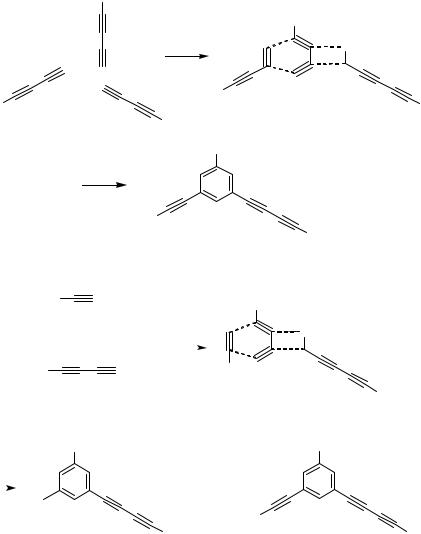
IV.10.2 Pd-CATALYZED BENZANNULATION REACTIONS |
1641 |
|
R |
|
|
|
R |
|
Pd(0) |
H |
|
R |
R |
|
|
R |
|
R |
|
|
R
R
R
Scheme 4
|
Ph |
|
|
n-C6H13 |
|
|
|
|
|
||
|
(1.0 mmol) |
|
|
H |
|
|
|
cat. Pd(PPh3)4 |
|||
+ |
|
||||
THF, 65 °C |
|
Ph |
|||
n-C6H13 |
|||||
15 h |
|||||
|
(0.5 mmol) |
|
|
n-C6H13 |
|
|
n-C6H13 |
|
|
n-C6H13 |
|
|
Ph |
+ |
|
n-C6H13 |
|
|
|
||||
|
|
|
|||
|
|
|
|
||
21% |
n-C6H13 |
n-C6H13 |
|||
|
|
|
|
24% |
|
Scheme 5
D. [4 2] ANNULATION OF CONJUGATED ENYNES
WITH DIYNES (CROSS-BENZANNULATION)
The scope of the reaction discussed in Sect. B is somewhat limited since the only practical synthetic procedure consists of the cyclodimerization of the two identical enynes, and therefore the same substituents are attached at the phenyl group and the vinyl group of the reaction product. The attempted cross-annulation of conjugated enynes with alkynes or dienes turned out to be unsuccessful. However, the scope of the benzannulation reaction could be extended significantly by introducing conjugated

1642 IV Pd-CATALYZED REACTIONS INVOLVING CARBOPALLADATION
diynes, which are highly reactive hydrocarbons in the presence of Pd catalysts (see Sect. C), as substrates for the reaction (Scheme 6). Thus, 2-substituted conjugated enynes reacted with conjugated diynes in the presence of Pd(0) catalysts to give 1,2,4- trisubstituted benzene derivatives in good yields (Table 8).[4] In this case, too, the product was formed in a highly regioselective manner, and other isomeric benzenes were not isolated. This reaction has been applied to the synthesis of oligosubstituted phenols (Table 9).[8] Unlike other reactions described in this section, some highly substituted
|
|
R1 |
R1 |
|
|
R1 |
Pd(0) |
R2 |
|
R |
2 |
|
|
|
|||
|
|
R2 |
R2 |
|
|
|
|
R1 |
|
|
|
+ |
R2 |
R1 |
|
|
|
|
|
|
|
|
|
|
|
R2 |
|
|
|
R2 |
|
|
R2 |
|
R2 |
|
|
R2 |
|
||
|
|
|
not formed |
|
|
Scheme 6
TABLE 8. Pd-Catalyzed Cross-Benzannulation of Conjugated Enynes with Diynes (1)
|
|
|
|
|
|
|
|
|
|
|
|
|
|
|
|
R1 |
|
R1 |
|
|
|
|
2 |
|
|
5 mol % Pd(PPh3)4 |
|
|
|||||||
2 |
|
R |
|
|
|
|
|||||||||||
+ R |
|
|
|
|
|
|
|
|
|
|
|
|
|
|
|||
|
|
|
|
|
|
|
|
|
THF, 100 °C |
|
|
R2 |
|||||
14 |
15 |
|
|
|
|
|
|
|
|
|
15 h |
|
|
||||
1.5−5 equiv |
|
|
|
|
|
|
|
|
|
|
|
|
|
|
|
R2 |
16 |
|
|
|
|
|
|
|
|
|
|
|
|
|
|
|
|
||
|
|
|
|
|
|
|
|
|
|
|
|
||||||
Enyne |
|
|
|
|
|
|
|
|
Diyne |
|
Yield (%) |
||||||
|
|
|
|
|
|
|
|
|
|
|
|
|
|
|
|
|
|
CH3 |
n-C4H9 |
|
|
|
|
|
|
|
|
|
|
n-C4H9 |
|
89 |
|||
|
|
|
|
|
|
|
|
|
|
|
|
||||||
|
|
|
|
|
|
|
|
|
|
|
|||||||
|
|
|
|
|
|
|
|
|
|
|
|||||||
|
Ph |
|
|
|
|
|
|
|
|
|
|
|
Ph |
|
>99 |
||
|
|
|
|
|
|
|
|
|
|
|
|
|
|
||||
|
|
|
|
|
|
|
|
|
|
|
|
|
|||||
|
|
|
|
|
|
|
|
|
|
|
|
|
|
||||
n-C6H13 |
Me3Si |
|
|
|
|
|
|
|
|
|
|
SiMe3 |
|
92 |
|||
|
|
|
|
|
|
|
|
|
|
|
|
||||||
|
|
|
|
|
|
|
|
|
|
|
|||||||
|
|
|
|
|
|
|
|
|
|
|
|
||||||
n-C4H9 |
|
|
|
|
|
|
|
|
|
|
n-C4H9 |
|
60 |
||||
|
|
|
|
|
|
|
|
|
|
|
|
||||||
|
|
|
|
|
|
|
|
|
|
|
|
||||||
|
|
|
|
|
|
|
|
|
|
|
|
||||||
PhCH2 |
n-C4H9 |
|
|
|
|
|
|
|
|
|
|
n-C4H9 |
|
89 |
|||
|
|
|
|
|
|
|
|
|
|
|
|||||||
|
|
|
|
|
|
|
|
|
|
|
|||||||
|
|
|
|
|
|
|
|
|
|
|
|||||||
|
|
|
|
|
|
|
|
|
|
|
|
|
|
|
|
|
|
|
Ph |
|
|
|
|
|
|
|
|
|
|
Ph |
|
86 |
|||
|
|
|
|
|
|
|
|
|
|
|
|
|
|
||||
|
|
|
|
|
|
|
|
|
|
|
|
||||||
|
|
|
|
|
|
|
|
|
|
|
|
|
|
||||
|
Me3Si |
|
|
|
|
|
|
|
|
|
|
SiMe3 |
|
80 |
|||
|
|
|
|
|
|
|
|
|
|
|
|
|
|||||
|
|
|
|
|
|
|
|
|
|
|
|
||||||
|
|
|
|
|
|
|
|
|
|
|
|
|
|||||
|
|
|
|
|
|
|
|
|
|
|
|
|
|
|
|
|
|
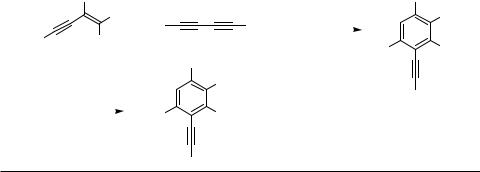
IV.10.2 Pd-CATALYZED BENZANNULATION REACTIONS |
1643 |
TABLE 9. Pd-Catalyzed Cross-Benzannulation of Conjugated Enynes with Diynes (2)
|
OR2 |
|
|
|
2 mol % Pd(PPh3)4 _ |
OR2 |
|
||
|
R1Z |
4 |
|
4 |
|
R1 |
|||
|
|
+ R |
R |
20 mol % P(o-Tol)3 |
|
|
|||
R3 |
R1E |
|
18 |
|
THF, 100 °C, 12 h |
|
R3 |
R4 |
|
|
17 |
|
|
|
|
|
|
||
|
|
|
OH |
|
|
|
|
|
|
TBAF (R2 = TBS) |
|
|
|
|
|
|
|||
|
R1 |
|
|
|
|
|
|||
|
or |
|
|
|
|
R4 |
19 |
||
|
|
|
|
|
|
||||
BBr3 (R2 = Me) |
|
R4 |
|
|
|
||||
|
|
R3 |
|
|
|
|
|
||
|
|
|
|
|
|
|
|||
|
|
|
|
20 |
|
|
|
|
|
R4
|
|
|
|
|
|
Yield of |
Yield of |
R1Z |
R1E |
R2 |
R3 |
R4 |
Methoda |
19 (%) |
20 (%) |
H |
H |
TBS |
n-Hex |
n-Bu |
Stepwise |
83 |
94 |
H |
H |
TBS |
n-Hex |
Ph |
Stepwise |
70 |
77 |
H |
H |
TBS |
Ph |
n-Bu |
Stepwise |
79 |
86 |
H |
H |
TBS |
Ph |
n-Bu |
One-pot |
— |
73 |
H |
H |
TBS |
Ph |
Ph |
Stepwise |
61 |
89 |
H |
H |
TBS |
Ph |
Ph |
One-pot |
— |
57 |
H |
Me |
TBS |
Ph |
n-Bu |
Stepwiseb |
66 |
92 |
Me |
H |
TBS |
Ph |
n-Bu |
Stepwise |
0 |
— |
H |
H |
Me |
H |
n-Bu |
Stepwise |
73(18)c |
75 |
H |
H |
Me |
H |
Ph |
Stepwise |
75 |
81 |
H |
H |
Me |
H |
Me3Si |
Stepwise |
41(36)c |
— |
a“Stepwise” corresponds to the stepwise reaction; that is, the protected phenol was isolated and then subjected to the deprotection. “One-pot” corresponds to the one-pot procedure; that is, the protected phenol was not isolated and was directly deprotected.
bThe reaction was carried out in the presence of 5 mol % Pd(PPh3)4.
cYield of the homodimerized product.
enynes such as 1,4-disubstituted, 2,4-disubstituted, and 1,2,4-trisubstituted enynes could be used as substrates for this reaction (Table 10).[13] The reactivity of the Z enynes or enynes containing an ester group appears to be higher compared to that of E enynes or enynes that do not contain an ester group.[14]
E. A MECHANISTIC RATIONALE OF THE
BENZANNULATION REACTIONS
Currently, the mechanism of these reactions is unclear, though some proposals appear in the literature without having decisive experimental evidence (Schemes 7–9).[3],[4] The initial step of this reaction should be the coordination of the alkyne moiety of the enyne or diyne to the Pd complex, since the coordinating ability of an alkyne is higher compared to that of an alkene. The Pd species formed via the insertion of the Pd into the acetylenic C—H bond cannot be an intermediate since the reaction of 4-substituted enynes proceeded smoothly (see Tables 2 and 3). Another enyne molecule might regioselectively
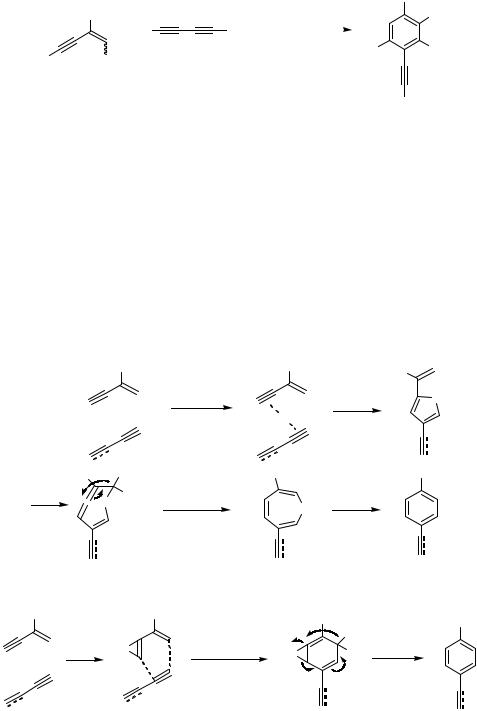
1644 IV Pd-CATALYZED REACTIONS INVOLVING CARBOPALLADATION
TABLE 10. Pd-Catalyzed Cross-Benzannulation of Conjugated Enynes with Diynes (3)
|
|
|
|
|
|
|
|
R2 |
|
|
R2 |
|
+ R4 |
R4 |
5 mol % Pd(PPh3)4 |
|
R1 |
||
|
|
|
|
|
|||||
|
|
|
|
|
|
|
|
||
|
|
|
|
toluene or THF, ∆ |
R3 |
R4 |
|||
|
|
|
|
|
|
||||
R3 |
|
R1 |
22 |
|
|
|
|
||
21 |
|
|
|
|
|
|
|||
|
|
|
|
|
|
|
|
|
|
|
|
|
|
|
|
|
|
|
23 |
|
|
|
|
|
|
Conditions |
R4 |
|
|
|
|
|
|
|
|
|
|
||
R1 |
R2 |
|
R3 |
R4 |
|
|
|
|
|
|
|
Temperature (°C) |
Time (d) |
Yield (%) |
|||||
H |
Me |
n-Hex |
n-Bu |
100 |
|
3 |
95 |
||
H |
Me |
Ph |
n-Bu |
100 |
|
3 |
79 |
||
H |
Me |
1-Cyclohexenyl |
n-Bu |
100 |
|
3 |
89 |
||
Me (88%-Z) |
H |
|
n-Hex |
n-Bu |
120 |
|
5 |
45a |
|
Me (84%-Z) |
H |
|
Ph |
n-Bu |
120 |
|
5 |
95a |
|
Me (Z) |
Me |
Ph |
n-Bu |
120 |
|
5 |
43a |
||
COOMe(Z) |
Me |
Ph |
n-Bu |
120 |
|
2 |
88 |
||
COOMe(E) |
Me |
Ph |
n-Bu |
120 |
|
2 |
42 |
||
H |
Me |
n-Hex |
Ph |
100 |
|
3 |
84 |
||
H |
Me |
Ph |
Ph |
100 |
|
3 |
80 |
||
H |
Me |
1-Cyclohexenyl |
Ph |
100 |
|
3 |
68 |
||
|
|
|
|
|
|
|
|
|
|
a TDMPP (tris(2,6-dimethoxyophenyl)phosphine) was used as an additive (20 mol %).
|
|
R |
|
R |
R |
|
|
|
Pd(0) |
|
Pd |
|
+ |
|
Pd |
|
|
R |
|
H |
|
R |
R |
• |
Pd |
H |
1,3-H shift |
|
|
|
|
Pd |
|||
|
|
|
|
|
|
Scheme 7
R |
R |
R |
|
R |
|
|
H |
||
|
Diels-Alder-type |
|
formal |
|
Pd(0) Pd |
|
|
||
reaction |
Pd |
H 1,3-H shift |
||
+ |
|
|
|
|
Scheme 8
